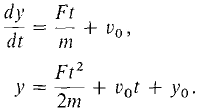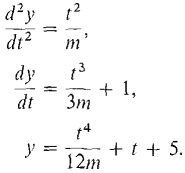| The ebook Elementary Calculus is based on material originally written by H.J. Keisler. For more information please read the copyright pages. |

|

Home  Exponential and Logartihmic Functions Exponential and Logartihmic Functions  Some Differential Equations Some Differential Equations  Examples Examples  Example 4 Example 4 |
|






|
|
Example 4
Newton's law, F = ma, states that force equals mass times acceleration. Suppose a constant force F is applied along the y-axis to an object of constant mass m. Then the position y of the object is governed by the second order differential equation
The general solution of this equation is found by integrating twice,
Setting t = 0 we see that the constants u0 and y0 are just the velocity and position at time f = 0. Thus the motion of the object is known if we know its initial position y0 and velocity y0. If the force F(t) varies with time we have the differential equation
The general solution can still be found by integrating twice, and the motion will still be determined by the initial position and velocity. Suppose for example that F(t) = t2, and y0 = 5, v0 = 1 at time f = 0. Then
|
|
Home  Exponential and Logartihmic Functions Exponential and Logartihmic Functions  Some Differential Equations Some Differential Equations  Examples Examples  Example 4 Example 4 |
|
Last Update: 2006-11-16





